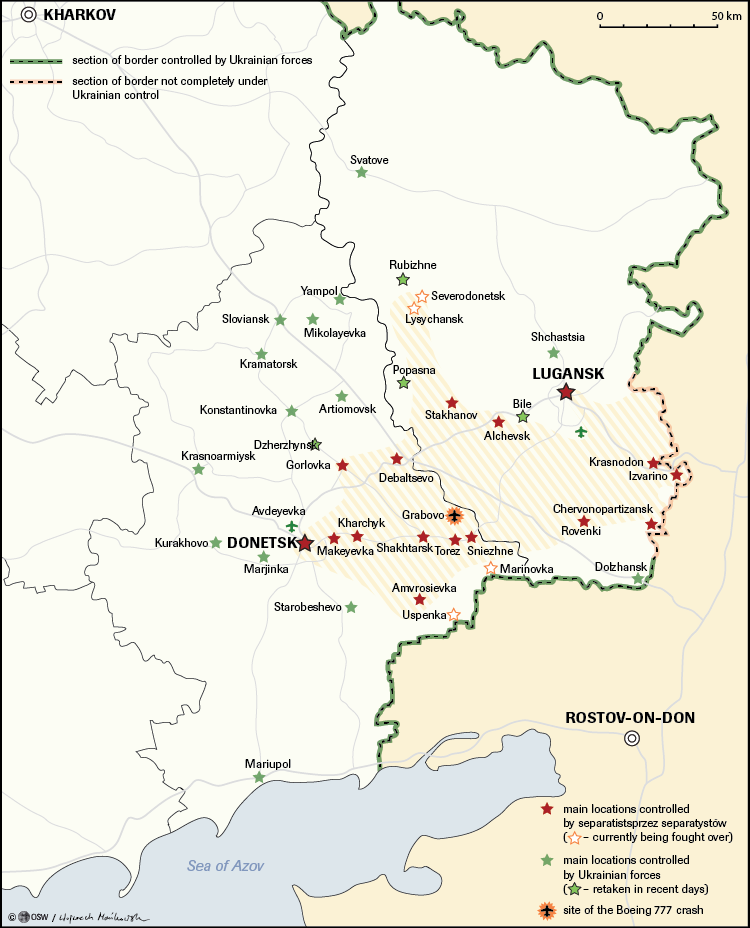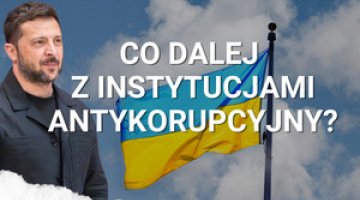The conflict in the Donbas after the shooting down of the Malaysian plane
On 17 July a Boeing 777 Malaysian Airline passenger aircraft (flight MH17 from Amsterdam to Kuala Lumpur) was shot down over a part of the Donetsk region controlled by separatists. The plane was hit by a rocket from a Buk-M1 system probably fired from the vicinity of Torez; its remains fell over an area of several kilometres, mainly in the vicinity of the village of Grabovo near Shakhtarsk. The Ukrainian authorities quickly provided evidence that the plane had been the target of a terrorist act, and put the blame for the tragedy on pro-Russian separatists. The President of Ukraine announced the appointment of an international commission of inquiry (with the participation of experts from Russia), and ordered government forces to halt hostilities within a radius of 20 km from the crash site, to allow the experts to do their work. Russia called for an independent investigation; it also blamed Ukraine for the Malaysian plane disaster, and exploited the tragedy to strengthen its campaign to discredit the Ukrainian state and force a ceasefire. In statements of 17 and 21 July, President Putin stated that there would not have been a tragedy if Kyiv had not resumed hostilities in eastern Ukraine. Furthermore, he called for an immediate announcement of a ceasefire and the resumption of peace negotiations.
The Malaysian aircraft tragedy did not stop the military operations carried out by separatists and government forces; nor is it likely to lead to the end of the armed conflict in the Donbas. Russia will not cease supporting the separatists with weapons and soldiers, and nor will the Ukrainian government cease its anti-terrorist operation. Armed clashes will continue, although the area of these will be limited. At the same time Ukraine’s position in this conflict has been strengthened; Kyiv has thus received international acquiescence to take more decisive military action. The West has intensified its criticism of Russia, while the separatists have been discredited as a party with whom Kyiv could have negotiated the future of the Donbas. This weakens the political position of Moscow, which in recent months has tried to force the West to recognise them as an independent actor and a party in the negotiations.
Ukraine’s measures since the crash of flight MH17
Immediately after the disaster, the Ukrainian authorities took active measures to seek information and conduct diplomatic activity, which clearly indicated that the plane had been shot down by pro-Russian separatists. Just five hours after the disaster, the Security Service of Ukraine published online recordings of conversations between a representative of the separatists, Igor Bezler, and a GRU General Vasily Gieranin, which confirm that the militants were responsible for shooting down the plane. Also the separatists themselves initially admitted to downing it, but when it turned out that it was an airliner that was hit, and not a Ukrainian An-26 military aircraft, they began to retreat from their previous declarations. In parallel, President Poroshenko called the Prime Ministers of the Netherlands and Malaysia to report the circumstances of the crash, and invited Dutch and Malaysian experts to join a committee investigating the circumstances of the tragedy. The Ukrainian commission would also include experts from the International Civil Aviation Organisation (ICAO) and “other international structures”. Poroshenko also held telephone conversations with US President Barack Obama and Vice President Joe Biden. Over the following days Poroshenko continued active consultations by telephone with the leaders of Germany, France, Poland, Holland, Great Britain, the USA and Australia, during which he emphasised the need for the establishment of an international commission on the disaster, and blamed the separatists for the tragedy as well as obstructing the emergency services from securing the victims’ remains. It was only in the evening of 21 July that refrigerated trains bearing the victims’ bodies set off towards Kharkiv, where on 23 July they were transported to the Netherlands. On 22 July, the separatists handed the ‘black boxes’ of the Boeing 777 to representatives of the government of Malaysia.
The Ukrainian authorities have carried out an efficient and effective information policy since the crash of the Malaysian aircraft. With strong evidence of the separatists’ guilt, and by publicising their incriminating operations at the crash site (plunder of the victims’ bodies, obstruction of the OSCE experts, the destruction of the remains of the aircraft), Kyiv has succeeded in persuading the West of its version of events. The Malaysian aircraft tragedy has sealed the notion in Western public opinion that Russia is giving military support to the separatists, and by the same token has discredited them as a direct partner in negotiating the future of the Donbas (as had previously been recommended by Berlin, Paris and Moscow). As a result, Ukraine has successfully resisted pressure from Russia and the West in the first days after the disaster to suspend its combat operations, which would have led to the freezing of the conflict in the Donbas. Although the government in Kyiv has strengthened its own position in the conflict with Russia and received a stronger mandate for decisive military action against the separatists, there is no sign of any real change in the position of the major EU capitals to become more deeply involved on Ukraine’s side in the conflict.
Russian reactions
Shortly after the plane crash Russia went on the diplomatic and propaganda offensive on the events in eastern Ukraine. On 17 July, President Vladimir Putin (on his own initiative) called President Obama and informed him about the incident; in the following days he held several telephone conversations with the leaders of certain EU countries, including the German Chancellor, France, the Netherlands and Great Britain. At the same time, Putin called for an impartial, international investigation to establish the causes of the plane crash, involving all interested parties, under the leadership of the ICAO, and assured that Russia was ready to participate in it. On 19 and 21 July, the Ministry of Defence of Russia disputed the accusation by Ukraine and the USA that pro-Russian separatists were responsible for the shooting down of the plane, and stated that Russia had not provided the militants with the Buk anti-aircraft missiles which the Malaysian aircraft could have been shot down by, or any other military equipment. A representative of the Russian General Staff also stated that Russia has evidence that the shooting down of the plane may be associated with the movements of Ukrainian forces. Moscow’s official pronouncements were accompanied by a campaign in the pro-Kremlin media aimed at convincing Russian public opinion that the Kremlin is not responsible for shooting down the civilian aircraft. The media coverage has put forward the thesis that responsibility for the disaster lies with the Ukrainian state; the shooting down of the plane may be a provocation by the West, or the result of a failed assassination attempt on President Putin.
The large number of official communiqués from Russia and the tempo at which they have been issued indicate that the Malaysian passenger plane crash came as a surprise for Moscow, and has caused concern in the Kremlin about the potential negative political and economic consequences for Russia if it is saddled with the responsibility for shooting down the plane. Thus, in its official reactions Moscow has tried to push aside the accusations of contributing to the tragedy, and has instead demonstrated its willingness to cooperate with the international investigation. On the other hand, the Kremlin has consistently put the responsibility for the tragedy on the government in Kyiv, and has undermined its credibility as a partner in the investigation. Russia’s reaction indicates that the Kremlin is now trying to minimise the losses to its image resulting from foreign public opinion blaming it for causing the disaster.
The next phase of Ukrainian operations in the Donbas
President Poroshenko’s command to cease combat operations within a 20-km radius of the site of the tragedy does not mean government forces have suspended their offensive in the Donbas, which confirms that Kyiv is not ready to reach a ceasefire agreement and halt its anti-terrorist operation. This decision demonstrates that Kyiv, while for its part guaranteeing international experts access to the remains of the aircraft, will continue to conduct military actions against the pro-Russian separatists. The observed activity of the Ukrainian forces shows that their main military objective is to cut off the separatists from their supply lines leading from Russia, to cut the roads connecting Donetsk and Lugansk, and to surround the separatists. The effectiveness of the Ukrainian actions is weakened – in addition to the problems of providing comprehensive supplies of troops, and the separatists’ sabotage actions at their rear – by the continued support for the separatists coming from Russian territory. This includes the entry into the Donbas of trained mercenaries (according to Ukrainian side these are citizens of the Russian Federation, who in many cases have been given ‘leave of absence’ from military units), as well as supplies of ammunition and heavy military equipment. This is possible because the Ukrainian forces have still been unable to regain control of the 20- to 30-kilometre stretch of the border with the Russian Federation in the Lugansk region.
There has been no decrease in the intensity of combat operations in the Donbas since 18 July. The fighting is continuing on the outskirts of Lugansk and Donetsk, among other areas. Ukrainian forces reported the capture of Dzerzhinsk, Rubizhne and Severodonetsk, localities north of Donetsk city, which demonstrates that the plan of gradually encircling the city is being implemented. According to Kyiv, shelling from the territory of Russia is continuing, as are supplies for the separatist forces and violations of Ukrainian airspace. The separatists are continuing the tactic of destroying the road infrastructure, which is aimed at impeding the mobility of the Ukrainian forces. On 19 July a bridge was blown up on the road leading to Lugansk from Severodonetsk, a town retaken later the same day by Ukrainian forces.
In addition, reports are constantly coming in about the presence on the Ukrainian border of units of the armed forces of the Russian Federation. A spokesman for the National Security and Defence Council, Andriy Lysenko, announced on 20 July that sub-units of mechanised and armoured Russian groups displaced from Zabajkalsk and the Far Eastern military districts have been observed in the Belgorod, Rostov and Bryansk border regions.
Forecast
The Ukrainian side will continue to reject the offers to halt the anti-terrorist operation, which means that a further escalation of the fighting should be expected. The intensity of these clashes and their operational success will depend primarily on cutting off the separatists’ supply routes from Russian territory (which is unlikely in the next few days), and whether the foreign military and technical assistance requested by the Ukrainian authorities will be delivered.
The shooting down of the Malaysian plane has revealed the key role Russia is playing in the armed conflict in the Donbas as well as its relationship with the separatists, which has led to a worsening of criticism of Russia by Western public opinion. In principle, the disgrace of the separatists excludes the possibility that the West will admit them as a party to the negotiations, which Moscow had sought for several months. This puts the Russian side in a difficult position. However, it is likely that the intensifying propaganda efforts by Russia and the appearances of ‘de-escalation’, and the Kremlin’s official distancing of itself from the separatists, will be accompanied by another diversion, designed to provoke an even greater destabilisation of eastern Ukraine. The absence of a tough response from the West will encourage Moscow to continue these activities. It cannot be ruled out, especially if Kyiv rejects the ceasefire, that there will be limited use of Russian armed forces in eastern Ukraine (including the bombing of Ukrainian territory), as well as terrorist acts outside the Donbas region.
It is most likely in the next few days that an international commission to investigate the crash of the Malaysian aircraft will be assembled; the process of securing the remains of the wreckage will take several weeks. The work of the committee will probably take many months, and its results will not directly influence the course of the conflict in the Donbas.
Map
Situation in eastern Ukraine (as of 23 July, 12pm CET)






